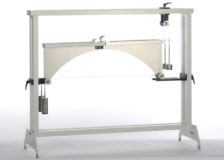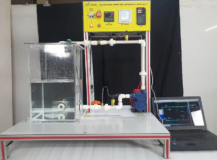Deformation of Trusses Model MT 032
Home » Products » Deformation of Trusses Model MT 032
Deformation of Trusses Model MT 032
Sci-tech Deformation of Trusses Model MT 032, the deformation of a single plane truss at one point is determined using Castigliano’s first theorem. The truss under investigation is made of bars joined together by a articulated construction using node discs. The trusses can be considered as ideal trusses. The bars have special snap-lock fixtures on their ends allowing them to be fixed easily into the node discs. A load application device attached to a node disc generates an external force.
The range of different bar lengths provided permits three forms of truss to be constructed. The bars are made of PVC, so their deformations are clearly visible.
| Size: | 110cm x 40cm x 102cm (LxWxH) |
| Weight: | 15 kg |
Item Description
Features
* Elastic deformation in a single plane truss1
* Construction of various truss forms1
* Application of Castigliano’s first theorem
When a component is placed under load it undergoes elastic deformation. This deformation can be calculated by determining elastic lines for example. Elastic lines describe the deformation of the complete component in the form of a mathematical equation. In reality, it is often only the deformation at specific points on the component which is of interest. Energy methods can be applied to determine these deformations more simply. Castigliano’s first theorem uses energy methods to calculate the deformation of a point on the component. The theorem is applicable to both statically determinate and indeterminate systems.
Sci-tech Deformation of Trusses Model MT 032, the deformation of a single plane truss at one point is determined using Castigliano’s first theorem. The truss under investigation is made of bars joined together by a articulated construction using node discs. The trusses can be considered as ideal trusses. The bars have special snap-lock fixtures on their ends allowing them to be fixed easily into the node discs. A load application device attached to a node disc generates an external force.
The range of different bar lengths provided permits three forms of truss to be constructed. The bars are made of PVC, so their deformations are clearly visible.
The well-structured instructional material sets out the fundamentals and provides a step-by-step guide through the experiments.
Technical Specifications
Specifications
[1] Investigation of the deformation of statically determinate trusses
[2] Construction of different truss forms possible
[3] 2 supports with node discs
[4] Load application device with force measurement dial gauge mountable on different node discs
[5] Dial gauge to record the deformation of the truss under load
[6] Cross arm for lateral stability of truss
[7] Storage system to house the components
Technical Specifications
Truss with 19 PVC bars
– height of truss max. 450mm
– length of truss max. 900mm
– bar lengths
2x 150mm
5x 259mm
7x 300mm
1x 397mm
3x 424mm
1x 520mm
– angle between bars: 30°, 45°, 60°, 90°
– maximum bar force: 200N
Load application device
– measuring range: -500…+500N, graduations: 10N
Dial gauge
– measuring range: 0…0,10mm, graduations: 0,01mm
Experiments
- Elastic deformation of truss under point load
- Calculation of support reaction and bar forces
- Principle of work and strain energy
- Application of Castigliano’s first theorem to calculate the deformation at a defined point.
- Verification of the calculated deformation possible by the principle of virtual work
- Comparison of the deformations of different trusses under the same load
- Comparison of measured and calculated deformation
Scope of Delivery
1 set of bars
5 node discs
2 supports with node disc
1 load application device
1 dial gauge with bracket
1 storage system with foam inlay
1 set of instructional material
Model Number
MT 032
See also different:

Sci-tech Three Hinged Arch Model MT 043 includes two long arch segments and one short segment, of which two at a time are connected by a hinged joint producing a symmetrical or unsymmetrical three-hinged arch. The arch under investigation can [...]



